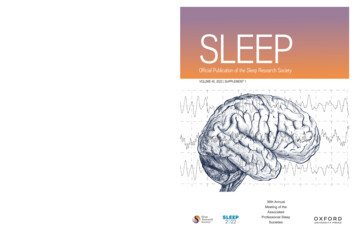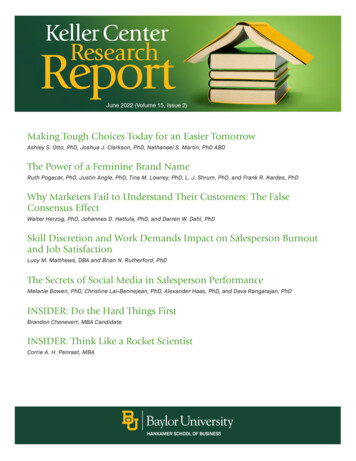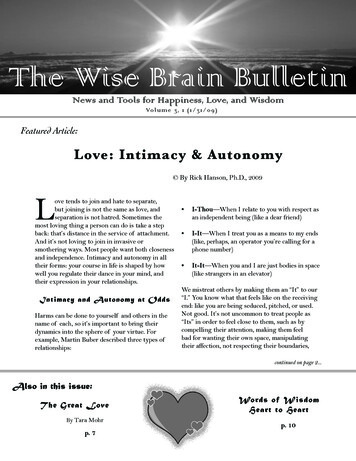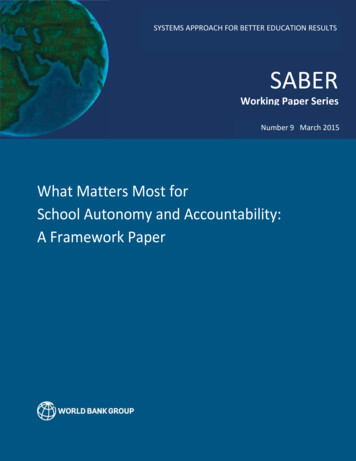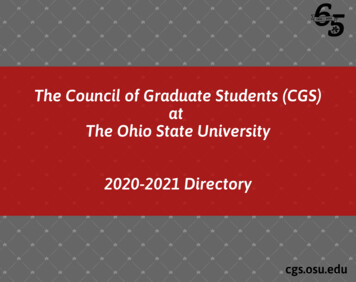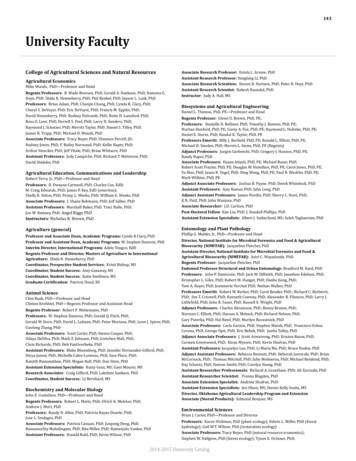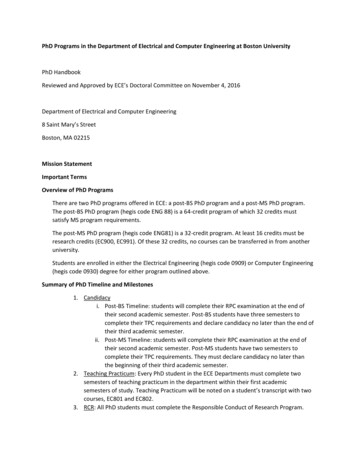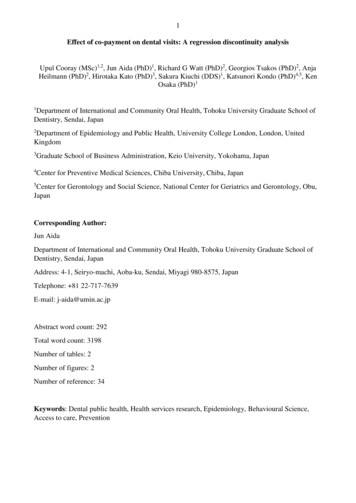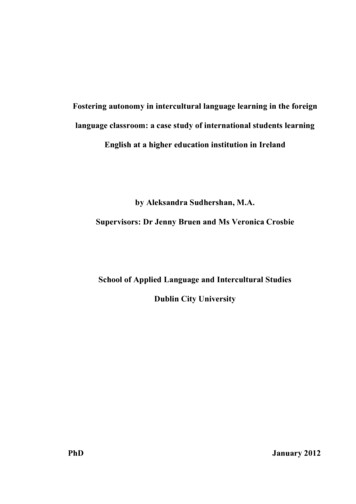
Transcription
Fostering autonomy in intercultural language learning in the foreignlanguage classroom: a case study of international students learningEnglish at a higher education institution in Irelandby Aleksandra Sudhershan, M.A.Supervisors: Dr Jenny Bruen and Ms Veronica CrosbieSchool of Applied Language and Intercultural StudiesDublin City UniversityPhDJanuary 2012
DECLARATIONI hereby certify that this material, which I now submit for assessment on the programmeof study leading to the award of Doctor of Philosophy is entirely my own work, that Ihave exercised reasonable care to ensure that the work is original, and does not to thebest of my knowledge breach any law of copyright, and has not been taken from thework of others save and to the extent that such work has been cited and acknowledgedwithin the text of my work.Signed:ID No.: 55137202Date:
To my Dad,who would be very proud
ACKNOWLEDGEMENTSFirst of all, I would like to sincerely thank my supervisors - Dr Jenny Bruen andVeronica Crosbie - for their invaluable guidance, constant encouragement, infinitepatience and constructive criticism during the course of my research. I truly could nothave wished for better supervisors and I really appreciate the fact that I could alwayscount on their support and understanding.Secondly, I am deeply grateful to “Liz” for inviting me into her classroom and to herstudents for welcoming me there. In particular, I would like to thank those students whoso generously agreed to take part in interviews, focus groups and think-aloud protocolsessions. Without them, this thesis would not have been possible.Finally, on a personal note, I would like to thank my husband, Dan, for his unwaveringbelief in me and for doing everything possible in his might to make the writing of thisthesis easier. To our two dearest sons, Miron and Eliasz, I can at last say that from nowon they are going to get my undivided attention. To my mom, I would like to say thankyou for taking care of the boys so that I could have more time to work on the thesis.Without their own personal sacrifices, big and small, I would have never been able tocomplete this task.Thank you.
TABLE OF CONTENTSABSTRACTiLIST OF TABLESiiLIST OF FIGURESiiiLIST OF ABBREVIATIONSivCHAPTER ONE:1Introduction1.1Introduction1.2Key terms: learner autonomy, intercultural competence andautonomy in intercultural language learning1.31Context: the internationalisation of higher education andinternational student mobility1.413Area of concern: the educational experience of internationalstudents51.5Research questions71.6Thesis outline9CHAPTER TWO:Learner autonomy in the foreign language classroom102.1Introduction102.2Conceptualising learner autonomy102.2.1The technical perspective112.2.2The psychological perspective122.2.3The socio-cultural perspective152.2.4The political-critical perspective162.2.5Converging the perspectives: a definition of learnerautonomy2.3Developing autonomy in the foreign language classroom212.3.1Focus on the process: the key factors212.3.2Focus on the learner: international students and theacquisition of learner autonomy2.418Assessing learner autonomy2529
2.5Conclusions32CHAPTER THREE: Foreign language learning and ing intercultural competence353.3Acquiring intercultural competence in the foreign languageclassroom3.440Assessing intercultural competence: from objective testing toassessment via the European Language Portfolio443.5Conceptualising autonomy in intercultural language learning543.6Conclusions57CHAPTER FOUR: Research methodology594.1Introduction594.2The “intellectual puzzle” and the research questions594.3Qualitative research methodology: an overview634.4The case study approach654.5Introduction to the case: LAN01 module684.5.1Case selection684.5.2Description of the case694.5.3The data collection process714.5.3.1Interviews724.5.3.2Classroom observation764.5.3.3Documents794.6Data analysis804.7Trustworthiness834.7.1Internal validity / credibility844.7.2Reliability / rigour874.7.3External validity / usefulness884.7.4Ethics904.8Summary91
CHAPTER FIVE:Fostering learner autonomy in a multiculturallanguage classroom935.1Introduction935.2.Setting students off on independent learning tracks955.3Developing the “learning software”1065.4Fostering interdependence1165.5Nurturing global citizens1205.6Summary125CHAPTER SIX:International students as autonomous interculturalspeakers6.1Introduction6.2Helping international students to become “independent explorers ofcultures”6.3126126127Maximising the potential of experiential learning in the languageclassroom: “interculturality in practice”1336.4Sowing the seeds of intercultural citizenship education1456.5Conclusions: developing learner autonomy and intercultural competencein a multicultural foreign language classroom147CHAPTER SEVEN: Discussion1517.1Introduction1517.2Study implications for international and foreign language education1517.3Fostering autonomy in intercultural language learning in a multiculturalforeign language classroom: criteria for course development1647.4Directions for future research1727.5Summary175CHAPTER EIGHT: Conclusions1768.1Introduction1768.2Summary of research findings1778.3Limitations of the study180
8.4Contribution to knowledgeBIBLIOGRAPHY181184APPENDICESAppendix AScreenshots of the LOLIPOP ELPiAppendix BLAN01 module documentsviB.1Module descriptorviB.2Assessment detailsviiiB.3Course overviewxDocuments pertinent to data collectionxiiC.1Overview of data sources used in the studyxiiC.2Sample “Reflection on learning” journal entryxvC.3Interview protocol for the first round of focus group interviewsxviC.4Sample focus group interview transcriptxixC.5Sample individual interview transcriptxliDocuments pertinent to data analysislD.1Sample screenshots of data analysis in Nvivo8lD.2Sample coded data (Codename: Being told what to do by theAppendix CAppendix Dteacher)liiiD.3Sample coded data (Codename: Self-assessment in uncomfortable) livD.4Sample coded data (Codename: LAN01’s multiculturalism fostersintercultural learning)lviSample coded data (Codename: Practising ethical consumerism)lxiiDocuments pertinent to research ethicslxivE.1Informed Consent FormlxivE.2Plain Language StatementlxvD.5Appendix E
ABSTRACTFostering autonomy in intercultural language learning in the foreign languageclassroom: a case study of international students learning English at a highereducation institution in IrelandAleksandra SudhershanThis study is concerned with the concept of autonomy in intercultural language learning,understood here as the capacity to take responsibility for one’s own language andintercultural development. It examines how such autonomy can be developed amonginternational students in the foreign language classroom as a means of helping thisstudent group to maximise the potential for language and intercultural development thatstudy abroad offers.To investigate this issue, a qualitative case study was designed which involved 30international students learning English in a higher education institution in Ireland over aperiod of one semester. The research drew on a variety of methods, including classroomobservations, focus group and individual interviews as well as documents. The datawere analysed by means of a computer-assisted qualitative data analysis software calledNVivo8.The results suggest that it is possible to implement an approach to learner autonomy thatnot only gives justice to its multifaceted nature, but also incorporates the concept ofintercultural competence. More specifically, it is argued that international studentsshould be given the opportunity to manage their intercultural language learning, developmetacognitive knowledge in relation to this process, work collaboratively with others todevelop intercultural interdependence and realise their potential as agents for change.Furthermore, the study highlights the relevance of tools, activities and approaches thatcan be used by the teacher to support the development of autonomy in interculturallanguage learning. These include: an interculturally enhanced version of the EuropeanLanguage Portfolio, reflection, collaborative learning and a critical pedagogicalapproach. While the potential and merit of the above are highlighted, their weaknesses,as viewed from an international student perspective, are also discussed. In addition,learner-related factors that may adversely affect student engagement with this approachare also analysed. Finally, drawing on the case study findings, the study suggests a setof criteria that need to be met if foreign language courses are to develop autonomy inintercultural language learning among this student population.i
LIST OF TABLESTable 2.1Conceptualisations of learner autonomy in foreign language20educationTable 4.1LAN01 class composition by country of originTable 4.2An overview of the different strategies used in this study toensure its qualityTable C.17091An overview of the different research methods and data sourcesused in the studyxiiii
LIST OF FIGURESFigure 1.1The research question and its sub-questions8Figure 4.1The research question and its sub-questions63Figure A.1Self-assessment gridiFigure A.2Intercultural self-assessment page (level A1)iiFigure A.3Intercultural self-assessment page (level A2)iiFigure A.4Intercultural self-assessment page (level B1)iiiFigure A.5Intercultural self-assessment page (level B2)iiiFigure A.6Intercultural self-assessment page (level C1)ivFigure A.7Intercultural self-assessment page (level C2)ivFigure A.8“Reflections on learning” pagevFigure D.1Screenshot of the database in NVivo8liFigure D.2Sample screenshot of the tree node structure in NVivo8(Sub-theme: Setting students off on independent learning tracks)Figure D.3liiSample screenshot of the tree node structure in NVivo8(Sub-theme: Learner-centred obstacles)iiilii
LIST OF ABBREVIATIONSBALLIBeliefs About Language Learning InventoryCEFRCommon European Framework of ReferenceCLILContent and Language Integrated LearningCMCComputer-Mediated CommunicationDMISDevelopmental Model of Intercultural SensitivityELPEuropean Language PortfolioFLEForeign Language EducationLOLIPOPLanguage On-Line Portfolio ProjectABBREVIATIONS USED IN THE REPORTING OF DATAFGFocus groupINTOne-to-one interviewJ“Reflection on learning” journalOBClassroom observationQEnd-of-semester questionnaireRRReflective report (in case of group reports, this is followed by a lettercorresponding to a given group)TAP INTInterview following a think aloud protocol sessioniv
CHAPTER ONE:INTRODUCTIONWhat the research literature suggests is that despite the seemingly enormous potential for thestudy abroad environment to produce gains in language acquisition and interculturalcompetence, students who study abroad often do not take full advantage of the language orculture learning experiences afforded them. (Paige, Cohen and Shively 2004 p.254)1.1IntroductionThe purpose of this introductory chapter is three-fold: firstly, to introduce the terms thatare central to this study, the context within which it is situated and its area of concern(sections 1.2, 1.3 and 1.4 respectively); secondly, to present the questions that havedriven this research (1.5); and finally, to provide an outline of the thesis (1.6).1.2Key terms: learner autonomy, intercultural competence and autonomyin intercultural language learningThe concepts of learner autonomy and intercultural competence have becomeubiquitous in the field of applied linguistics. The former, captured in Holec’s (1981 p.3)seminal definition as “the ability to take charge of one’s own learning”, has pervadedthe theory and practice of foreign language teaching for over three decades. Moreover,it is unlikely that its appeal is going to diminish in the near future as is evident from thefact that the number of publications on the topic that appeared in the 2000s “exceeds theliterature published over the previous 25 years” (Benson 2006 p.21). One of the mainreasons for its enduring popularity is a belief that learner autonomy is a prerequisite forsuccessful (language) learning (Little, Ridley and Ushioda 2002 p.1). Indeed, empiricalevidence suggests that classroom practice in which the development of autonomy is anexplicit pedagogical goal can lead to remarkable linguistic progress, often far exceedingthat achieved by learners exposed to traditional teacher- and textbook-centred1
instruction (Legenhausen 2000). As a result, it is argued that fostering learner autonomyin the classroom is “not an optional extra” (Little, Ridley and Ushioda 2002 p.1;emphasis added; see also Benson and Voller 1997 p.11).Turning to the second key term used in this thesis, it is now generally accepted, even ifstill not widely practised, that “all language education should always also beintercultural education” (Sercu 2002 p.72). This particular direction in foreign languageteaching and learning encourages learners to develop intercultural communicativecompetence (Byram 1997). It emphasises, as the name suggests, the need to foster notonly communicative, but also intercultural competence in the language classroom, withthe latter understood as a composite of an individual’s intercultural knowledge, skillsand attitudes. The process of the development of such a competence in the classroomenvironment has been captured for the purpose of this study in the term interculturallanguage learning.This study argues that if we accept the inseparability of communicative and interculturalcompetences in FLE, then the development of learner autonomy should also be vital foreffective intercultural language learning. Yet, the need to integrate the concepts oflearner autonomy and intercultural competence has been recognised only recently (seeBenson 2006 p.25), and to date, relatively little attention has been paid to this approachin the field. The purpose of this study is to redress the balance as it examines theconcept of autonomy in intercultural language learning, defined for the purpose of thisthesis as the capacity to take responsibility for one’s own language and interculturaldevelopment.2
1.3Context: the internationalisation of higher education and internationalstudent mobilityThe literature dedicated to higher education that has been published in the last twodecades contains many references to its internationalisation (e.g. Fortuijn 2002, Otten2003, Knight 2004, Guo and Chase 2011), thus reflecting the growing importance ofthis process to the third-level sector. Although highly versatile and therefore difficult todefine, the term can be understood as “the process of integrating an international,intercultural or global dimension into the purpose, functions or delivery of postsecondary education” (Knight 2003 p.2; as cited in Knight 2004 p.11; emphasis added).One particular manifestation of internationalisation that is of direct relevance to thisstudy concerns student mobility across national borders (Fortuijn 2002 p.264). In theEuropean context international student1 mobility is said to have already become animportant feature of the higher education landscape (Kelo, Teichler and Wächter 2006).Andrade (2006 p.132) writes that it is now “a common practice” for students to doeither a full degree, or part of it, abroad, and as far as short-term student mobility isconcerned, EU initiatives such as the Socrates / Erasmus programme have beeninstrumental in its facilitation (Coleman 1998). In the case of Ireland, in which thisparticular study is situated, most recent data available show that almost 29,000international students were enrolled in the Irish tertiary level institutions in theacademic year 2009/10 (Education Ireland 2010 p.4).1In the context of this study, the term international student is used to refer to “a student whoundertakes part or all of their higher education experience in Ireland, if Ireland is not their homecountry” (International Education Board Ireland 2004 p.8).3
The internationalisation process, however, appears to be something of a double-edgedsword, mainly because of the fact that at its heart lies a “diversity paradox” (Fortuijn2002). This means that diversity is both “the ultimate reason for internationalisation”and “the main problem” in this process (ibid. p.264). On the one hand, internationalstudent mobility offers a number of benefits. As far as higher education institutions areconcerned, the effort that is made by them to attract international students is oftendriven by the need to raise vital revenue (Andrade 2006 pp.132-133; Lebcir, Wells andBond 2008 p.268). In relation to pedagogical benefits, it is argued that cultural diversityon campus:makes the university vibrant, enables contact, understanding, and sharedexperiences between students from different cultural and ethnic backgrounds,and allows university staff to broaden their knowledge about the educationsystems in different countries. (Lebcir, Wells and Bond 2008 p.268; emphasisadded)In other words, the presence of international students on campus is expected to be anenriching factor, particularly because it can facilitate intercultural learning (see alsoOtten 2003 p.13 and Andrade 2006 p.133). Consequently, the experience of studying inanother country is said to have the potential to be “transformative” for internationalstudents (Bennett 2008, Hunter 2008), particularly in terms of the opportunities itpresents for language and intercultural development2, an issue that is of direct relevanceto this study.On the other hand, even though there is substantial evidence to suggest that a sojournabroad can generally lead to a significant improvement in an individual’s2Ife (2000 p.30; emphasis added) writes, for example, that, “within the European context [ ]movements of students are [ ] part of the European policy of generating interculturalcommunication between European nations and few doubt the beneficial effects socially,culturally and linguistically of such experience”.4
communicative and intercultural proficiency (see, for example, Freed 1998, Engle andEngle 2004, Jackson 2006, Rees and Klapper 2007, Llanes and Muñoz 2009, Williams2005, Gill 2007, Ruddock and Turner 2007), we also know that “cultural diversity andinternationalisation do not automatically lead to intercultural contacts and interculturallearning experiences” (Otten 2003 p.14; emphasis added). In addition, in light ofsubstantial fees that are sometimes paid by international students for their education, thequestion arises as to whether they receive “value for money” in terms of hostinstitutions being aware of, and accommodating, the specific academic needs they mayhave (see, for example, Sheridan 2011). Unfortunately, as pointed out by Guo andChase (2011 p.306), even though international students may comprise a significantpercentage of the student population at a host university, often little is known about how“they adapt to an academic environment substantially different from their own, with adifferent language, culture and pedagogical traditions”. In fact, international studentsare often expected to “fit into” the new academic environment, even though they mayface significant academic challenges (Sheridan 2011). Such obstacles are the focus ofdiscussion in the following section.1.4Area of concern: the educational experience of international studentsAs pointed out by Swaminathan and Alfred (2003 p.31; emphasis added), “immigrants[ ] arrive with images about higher education cultures and some are often bothsurprised and dismayed at what they meet in the new country”. This observation raisesthe issue of the gap that often exists between what international students may expectfrom a host institution and what in turn is expected of them, and which is likely to putthem at a disadvantage when it comes to classroom learning.5
For example, immigrant students are often accused of remaining silent during classroomactivities; yet, the reason for their silence can be attributed to the initial “learningshock” experienced (Swaminathan and Alfred 2003 p.31). Insufficient languagecompetence is particularly challenging (e.g. Sheridan 2011) and can lead to inequality,or “asymmetric power structures” in the classroom (Otten 2003 p.16). This is becauseacademic staff and host students have an advantage over international students withregard to the former’s ability to communicate in the mother tongue and familiarity withthe cultural setting and institutional requirements. Fortuijn (2002 p.267) writes, forexample, that, “[i]n a multinational session with native and non-native speakers there isalways the danger of relating differences in language mastery to differences in academicquality”. In other words, there is a perception that native speakers are moreacademically skilled by virtue of their fluency in the language.Furthermore, even though campus diversity is expected to benefit studentsinterculturally, cultural differences can be a source of tension between internationalstudents on the one hand, and academic staff and host students on the other. It is argued,for instance, that academic staff often do not know how to address cultural differenceappropriately in the classroom as they either ignore it, emphasising commonalityinstead and in this way rendering immigrant students “invisible”, or single it out, thuspotentially making them uncomfortable (Swaminathan and Alfred 2003). Therelationship between international and host students is also likely to be fraught withdifficulties as the former have reported finding it difficult to make friends with domesticpeers (Sheridan 2011), and may consequently choose to self-segregate both in and outof class (Swaminathan and Alfred 2003, Otten 2003, Sheridan 2011).6
As the above discussion shows, international students’ academic achievement can besignificantly undermined by linguistic and cultural differences that are manifest in theclassroom environment. This naturally raises the question of whether host institutionscan do more in order to prevent international students from missing on the opportunitiesthat an educational experience in a host country presents with regard to interculturallanguage learning (see Llanes and Muñoz 2009), especially as language professionalshave been called “to try to ensure that students benefit to the maximum from theirexperience abroad” (Ife 2000 p.30). This study argues that helping international studentsto develop “the competence to learn [languages and] cultures autonomously” (Sercu2002 p.72) can be part of the solution to the problem, an issue that brings us directly tothe research questions behind this study.1.5Research questionsThis study focuses on fostering autonomy in intercultural language learning in amulticultural foreign language classroom in a study abroad context. Even thoughlearners may have a natural inclination to take control of their learning, the developmentof true autonomy requires systematic support (Benson 2001 p.75). This point isemphasised by Holec (1981 p.3; emphasis added), who writes that autonomy “is notinborn but must be acquired either by ‘natural’ means or (as most often happens) byformal learning”. Consequently, the role that the language classroom can play in thedevelopment of autonomy in general, and autonomy in intercultural language learningin particular, cannot be underestimated. However, little research exists that can offerinsight into what language professionals can do in order to foster such autonomy.Consequently, the purpose of the current study is to investigate, by means of aqualitative case study the following research questions:7
Research Question: How can international students in a multicultural foreignlanguage classroom be supported in the development of autonomy in interculturallanguage learning?RQ1: Given the multifaceted nature of learner autonomy, what opportunities can amulticultural foreign language classroom environment provide for internationalstudents to take more control of their intercultural language learning?RQ2: What obstacles can prevent international students from developing autonomy inintercultural language learning with regard to: a) their own beliefs and expectations;and b) the learning environment?Figure 1.1The research question and its sub-questionsIn light of the emphasis on language competence in autonomy-oriented classrooms, thisstudy, by answering the above questions, is significant as it brings the current debate onlearner autonomy up to date with recent developments in foreign language education(FLE), namely the emergence of an intercultural approach. In addition, it provides acomprehensive appraisal of learner autonomy as a construct as it examines it frommultiple perspectives. Furthermore, this study has important implications for classroompractice not only by virtue of its innovative approach to learner autonomy, describedabove, but also because of the fact that it advances further the cause made in recentyears of a more culturally sensitive pedagogy (e.g. Otten 2003). By focusing on the“voices” of international students (Krishnan and Hwee Hoon 2002), the study also addsto the existing body of knowledge concerning the study abroad experience in general.More importantly, it aims to improve language professionals’ understanding of thedifficulties that may be experienced by this particular student population as far as8
fostering autonomy in intercultural learning is concerned, while also offeringsuggestions for addressing them.1.6Thesis outlineThe structure of this thesis is as follows: the literature pertinent to this study is reviewedin Chapters Two and Three. More specifically, Chapter Two focuses on the fourdifferent perspectives on autonomy that have been identified in the literature to date, theprocess of acquiring autonomy in the language classroom as well as the issue ofassessment. Chapter Three focuses in turn on the definition, development andassessment of intercultural competence in the context of FLE before it turns to theconcept of autonomy in intercultural language learning.The two literature review chapters pave the way for the empirical section of the thesis:Chapter Four begins with an examination of the research questions behind this studybefore presenting the methodological approach adopted in its design. This is followedby the presentation of case study findings in Chapters Five and Six, and the discussionthereof in Chapter Seven, which also offers recommendations for further research. Thethesis concludes with a summary of key findings and a discussion concerning itslimitations as well as contribution to knowledge in Chapter Eight.9
CHAPTER TWO:LEARNER AUTONOMY IN THE FOREIGN LANGUAGECLASSROOM[A]utonomy is an essential characteristic of all truly successful learners, regardless of their ageor the domain in which they are learning. (Little, Ridley and Ushioda 2002 p.1)2.1IntroductionIn order to be able to support international students in the development of learnerautonomy in the language classroom, we must know what exactly the concept involves.Accordingly, this chapter begins with a detailed examination of the construct that pavesthe way for its definition (section 2.2). This is then followed by a discussion of what theprocess of developing learner autonomy in the classroom entails in practice (2.3). Sincethe experience of international students is central to this study, the acquisition process isalso examined from the perspective of this student population. Finally, the chapterexamines the issue of how learner autonomy can be assessed in a formal learningcontext (2.4).2.2Conceptualising learner autonomyEven though it was introduced to FLE over three decades ago, the concept of learnerautonomy is still beset by conceptual and terminological confusion (Benson and Voller1997 pp.1-2, Oxford 2003 p.75). For example, according to Benson and Voller (1997pp.1-2; emphasis original), the term can be used to denote any of the following:1. [ ] situations in which learners study entirely on their own;2. [ ] a set of skills which can be learned and applied in self-directed learning;3. [ ] an inborn capacity which is suppressed by institutional education;4. [ ] the exercise of learners’ responsibility for their own learning;5. [ ] the right of learners to determine the direction of their own learning.10
As the above quote illustrates, the term learner autonomy can take on differentmeanings in different contexts; consequently, any attempt to provide a comprehensivedefinition of the concept, such as the one made in section 2.2.5, must take such differentunderstandings into account. Oxford’s (2003; see also Benson 1997 and Murase 2009)suggestion to distinguish between four perspectives on the construct - technical,psychological, socio-cultural and political-critical - is particularly useful in this regard.All four perspectives will be discussed in detail in the following four sub-sectionsrespectively.2.2.1The technical perspectiveAccording to Holec’s (1981 p.3) seminal definition, autonomy is a matter of the learnerhaving the ability, or “a potential capacity”, to “take charge of [his or her] ownlearning”. In practical terms this means that the learner accepts responsibility formaking decisions in respect of the five key components of the learning process, fromspecifying the objectives and contents, through selection of methods and techniques, tomonitoring the acquisition procedure and evaluation of both what s/he has learnt and ofthe learning process itself (ibid.)3. For Holec, a learner who is autonomous “is himselfcapable of making all these decisions” (ibid.).Although Holec’s view of autonomy has certainly been influential, and his views haveechoed through much of the literature on learner autonomy (e.g. Dickinson 1987,3A number of authors (e.g. Holec 1981, Dickinson 1987, Benson 2001) make a distinctionbetween autonomy and self-directed learning. For example, Benson (2001 p.34) states thatwhere
Fostering autonomy in intercultural language learning in the foreign language classroom: a case study of international students learning . Dr Jenny Bruen and Ms Veronica Crosbie School of Applied Language and Intercultural Studies Dublin City University PhD January 2012 . DECLARATION . CMC Computer-Mediated Communication DMIS Developmental .
